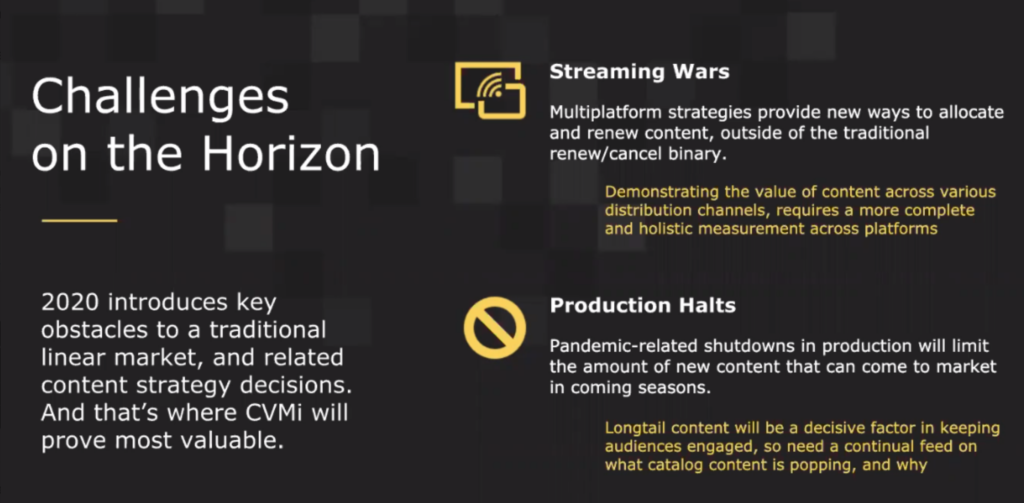Connections

Whip Media: Success of New TV Shows Can Be Predicted Before Ratings Come In
Story Highlights
While TV networks continue to rely mainly on viewership ratings to determine whether or not a freshman TV series should be renewed, there is significant value in being able to gauge how successful a show may be before it ever airs, according to Carlen Wilutis, senior manager, client success at Whip Media Group.
“We know we need to look beyond ratings to understand what indicates a successful freshman season” for a TV show and “to understand why consumers are watching,” she said Aug. 27 during the WhipFlash Webinar “Predicting Fall Debut Series Performance: Renew or Redline.”
At the start of the webinar, Jerry Inman, the company’s chief marketing officer, pointed out: “2020 – what a year, with COVID-19, production halts, scheduling delays and an unprecedented flurry of streaming platform launches – [and] let’s not forget social shifts [that] will impact everything.”
Predicting a show’s success before it airs can help broadcasters and advertisers make decisions and plans much earlier, according to Whip Media.
“In an increasingly competitive, multiplatform market, prescient knowledge with considerable breadth across various ecosystems is both critical, and hard to come by,” the firm pointed out in an accompanying white paper.
Therefore, over the past three years, Whip “tapped into our dataset to gauge whether consumer behavior, like following a show within our TV Time app, is in line with greater industry outcomes like a series being renewed for a second season,” Wilutis said.
In the first year of the study, Whip looked at the 2017-2018 season, observing the top-performing shows ranked by followers in the TV Time app 40 days prior to their debut broadcasts, she noted, pointing to the company’s CVM Insights data. All six broadcast renewals came from the top 10 shows by TV Time follower accounts, she added.
For the 2018-2019 season, all the TV Time/CVM Insights top 10 were renewed, so the data proved to be even more accurate than in year one, she said.
For the most recent 2019-2020 season, 80% of the top 10 were renewed, she noted. Two shows – CBS’s “Bob Hearts Abishola” and Fox’s “Bless the Harts” – came in 15th and 16th place, respectively, in the TV Time/CVM Insights U.S. Follower Rank, right at the bottom. However, they ended up being renewed anyway – an “anomaly to prior seasons,” Whip Media noted in its white paper.
 To better understand the possibility for a program’s growth post-launch, therefore, the company “developed a follower growth rate to navigate a show’s ability to build an audience in season and over time,” Wilutis told viewers. It measures follower growth from weeks 3 through 10 of a show, near the winter hiatus — a period she called a perfect one to better understand the show’s “true sustained following while removing” the heavy marketing a show gets early on. A show’s longevity and word-of-mouth potential are two key issues factored into the equation.
To better understand the possibility for a program’s growth post-launch, therefore, the company “developed a follower growth rate to navigate a show’s ability to build an audience in season and over time,” Wilutis told viewers. It measures follower growth from weeks 3 through 10 of a show, near the winter hiatus — a period she called a perfect one to better understand the show’s “true sustained following while removing” the heavy marketing a show gets early on. A show’s longevity and word-of-mouth potential are two key issues factored into the equation.
CVM Insights “moves beyond linear ratings to capture audience value,” according to Whip Media, which noted its goal was to “understand not only viewership but also consumer intent.”
“There are still some challenges to consider when it comes to [evaluating] TV programing for future seasons,” Wilutis said.
For one thing, it is becoming increasingly important that streaming platforms and programs are taken into account. In 2020, the streaming wars are a major factor, with multiplatform strategies providing new ways to allocate and renew content outside of the traditional renew/cancel “binary,” according to Whip Media.
Shows such as “Batwoman” and “Nancy Drew” require multiplatform measurement to determine viewership volume and success because they are targeted at millennial and Gen Z viewers, the company pointed out.
“It’s no longer that black and white question of renew or redline, but renew, redline or let’s just bump it to a streaming platform,” Wilutis said, explaining: “Traditional measurements like ratings don’t capture that holistic picture needed to confidently make these decisions and it’s also important to consider long-term value of that existing content.”
In the future, it might make sense for certain programs to go straight to streaming, she noted.
The other major challenge of 2020 is, of course, the COVID-19 pandemic, which caused production shutdowns limiting the amount of new content that can come to market in the coming seasons, according to Whip Media.
“Longtail content will be a decisive factor in keeping audiences engaged,” so there is the need for a “continual feed on what catalog content is popping, and why,” the company pointed out.









